
Gen Z Movement exposes Rs 9 billion government vehicle spree, forcing a long-overdue review of public expenditure and elite facilities
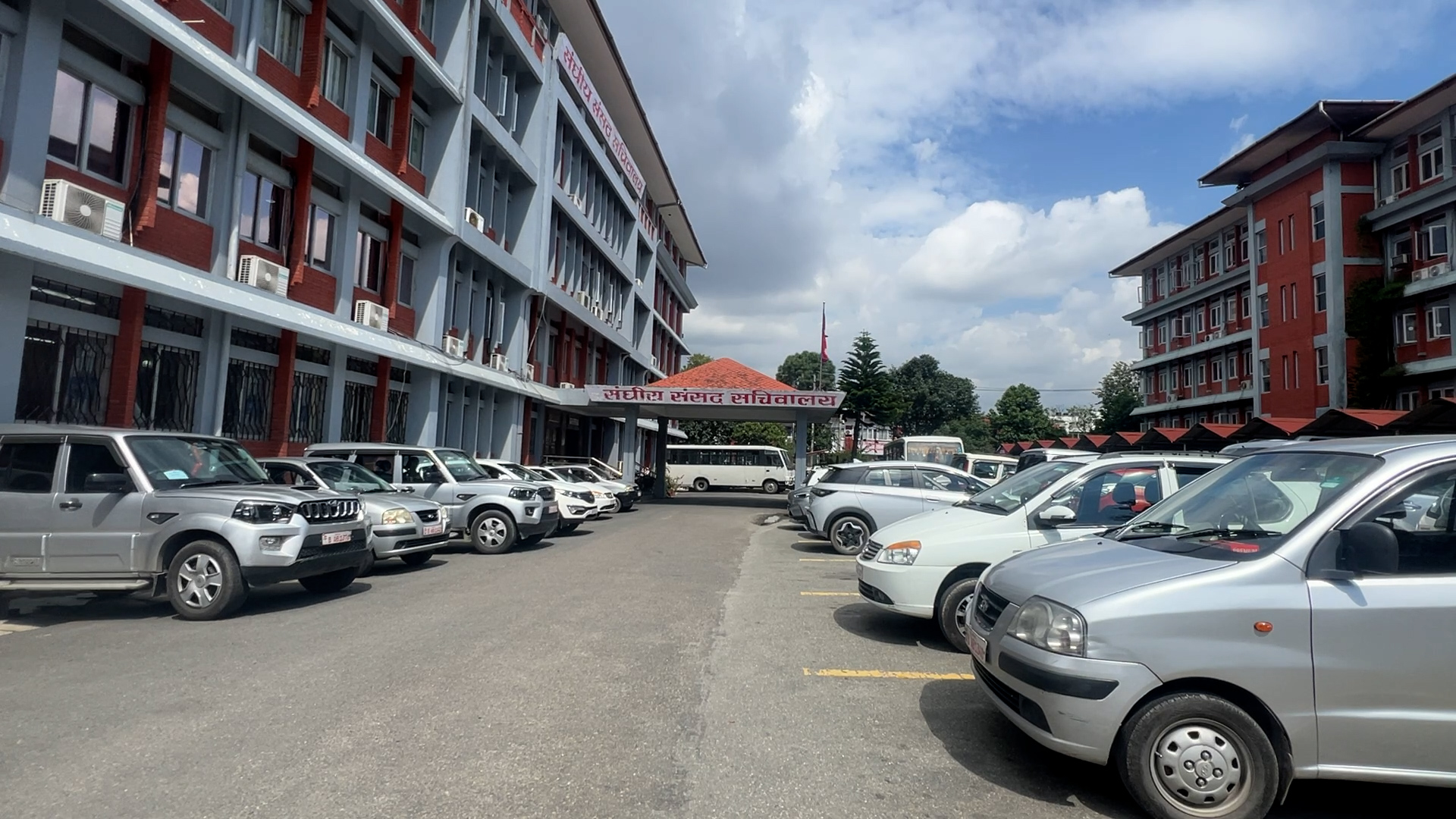
KATHMANDU: On September 9, the second day of the Gen Z movement, hundreds of government vehicles were damaged during vandalism and arson attacks on Singha Durbar and government offices outside.
According to Kathmandu District Police Range Spokesperson Pawan Bhattarai, more than 2,000 two-wheelers and four-wheelers, both inside and outside Singha Durbar, were burned. Some ministries and government bodies have yet to release a detailed report on the vehicle damage.
Government vehicles are provided to public office holders and employees as a facility. There is a system of providing a lump sum amount monthly for the necessary fuel, maintenance, and driver’s salary for these vehicles.
As a result, a large portion of the state budget has been spent under the vehicle category. In recent fiscal years, the budget allocated for this category has hovered around 8 to 9 billion rupees annually.
There has been public commentary and criticism that the poor country squanders taxes paid by the public by buying expensive vehicles in the name of facilities, that the vehicle facility is severely misused, and that it adds a burden to the government treasury.
Since a large number of government vehicles were burned and destroyed in the Gen Z movement, there is also an apprehension that the purchase of new vehicles to replace them will start sooner or later. However, the interim government formed after the movement has adopted a policy of practicing austerity in public spending and not purchasing new vehicles.
This time presents an opportunity to control the expenditure of state funds on government vehicles, prevent the misuse of facility vehicles, and manage them sustainably. In a country with weak economic capacity, stopping the wasteful spending on facility vehicles can be a starting point for reining in extravagant expenses.
Home Ministry’s excessive spending
Among the ministries, the Ministry of Home Affairs appears to have the largest number of vehicles. Before the Gen Z movement, the Home Ministry had a total of 198 vehicles, including 78 four-wheelers and 120 two-wheelers. Besides these, there were 7,648 vehicles under the Home Ministry’s subordinate bodies. Thus, 7,846 vehicles are under the purview of the Home Ministry alone.
According to Home Ministry Spokesperson Ananda Kafle, a total of 44 vehicles—including 23 four-wheelers and 21 motorcycles—were destroyed during the Gen Z movement.
Previously, the Home Ministry allocated a budget under four headings every year for the operation and management of vehicles for government employees and high-ranking officials. The budget is spent on driver’s salary, fuel, new vehicle purchase, and vehicle maintenance.
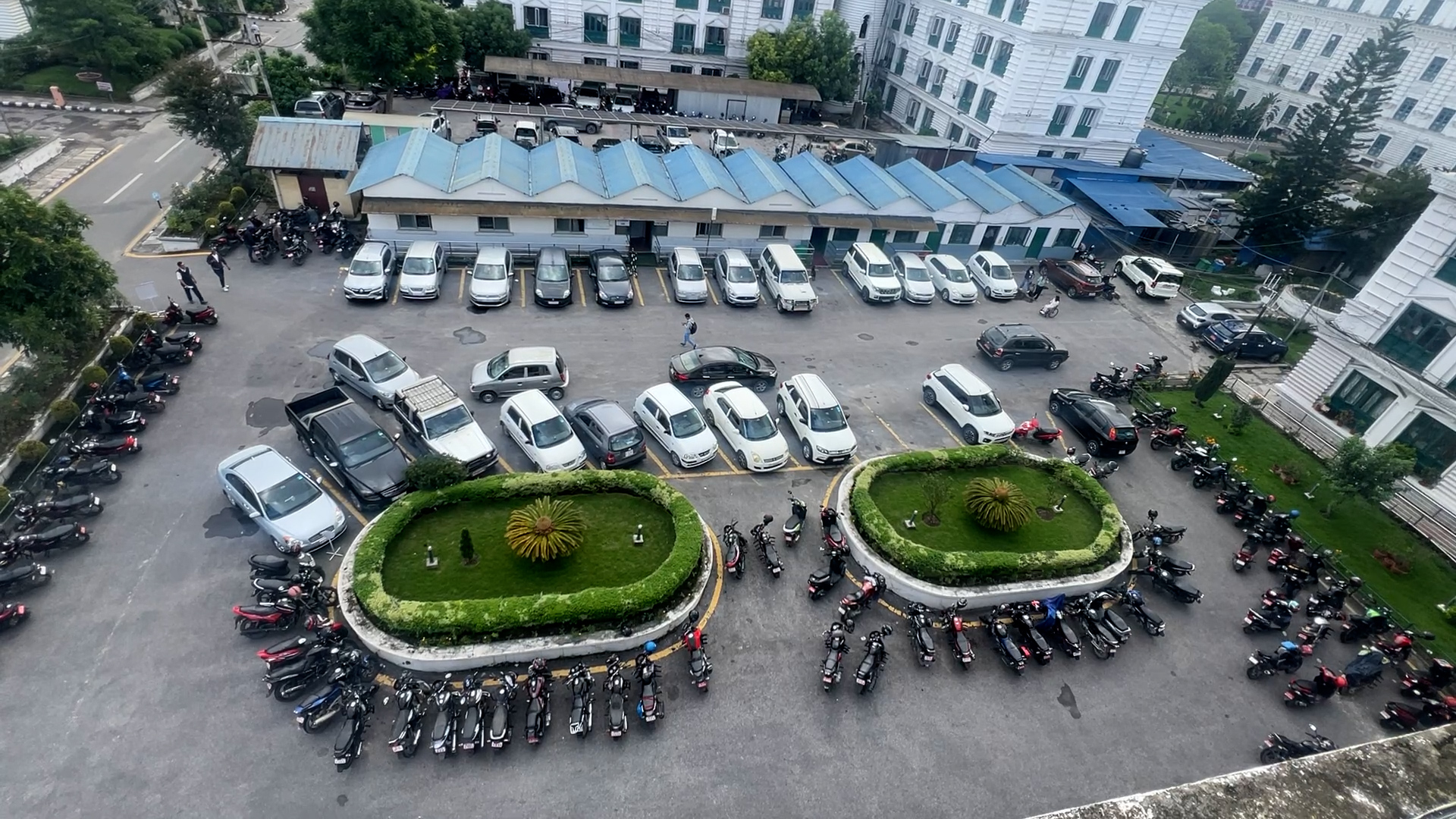
The parking lot of Ministry of Finance inside SIngha Durbar premises on August 11, 2025. Photo: Shikha Shrestha/Nepal News
The total size of the budget allocated under these headings is large. Apart from the initial budget allocation under these headings, concerned bodies frequently request additional funds from the Ministry of Finance every year under the same headings based on their own discretion and by demonstrating the necessity.
According to details obtained by Nepal News, the Home Ministry received the highest budget under the vehicle category in the five years since the fiscal year 2020/21. Fuel is the vehicle-related budget heading that incurs the most expenditure in government offices.
The Home Ministry spent over 6.93 billion rupees on fuel in the last five years. More than 446.3 million rupees was allocated for driver’s salary. Similarly, over 3.52 billion rupees was spent on vehicle maintenance and approximately 1.94 billion rupees on new vehicle purchases in the last five years.
In total, over 12.85 billion rupees was allocated to the Home Ministry under the four vehicle-related headings from the fiscal year 2020/21 to 2024/25). Out of this amount, 1.75 billion rupees was later requested as additional funds citing insufficiency.
The expenditure on vehicles at the Home Ministry is increasing every year. The size of the budget under the headings of driver’s salary, fuel, maintenance, and new purchases at the Home Ministry has been growing annually. For the current fiscal year 2025/26, 3.44 billion rupees has been allocated.
After the Home Ministry, the Ministry of Agriculture and Livestock Development ranks second in terms of the number of vehicles. The Public Asset Management System (PAMS) record under the Office of the Auditor General shows that there are 2,659 vehicles under this ministry.
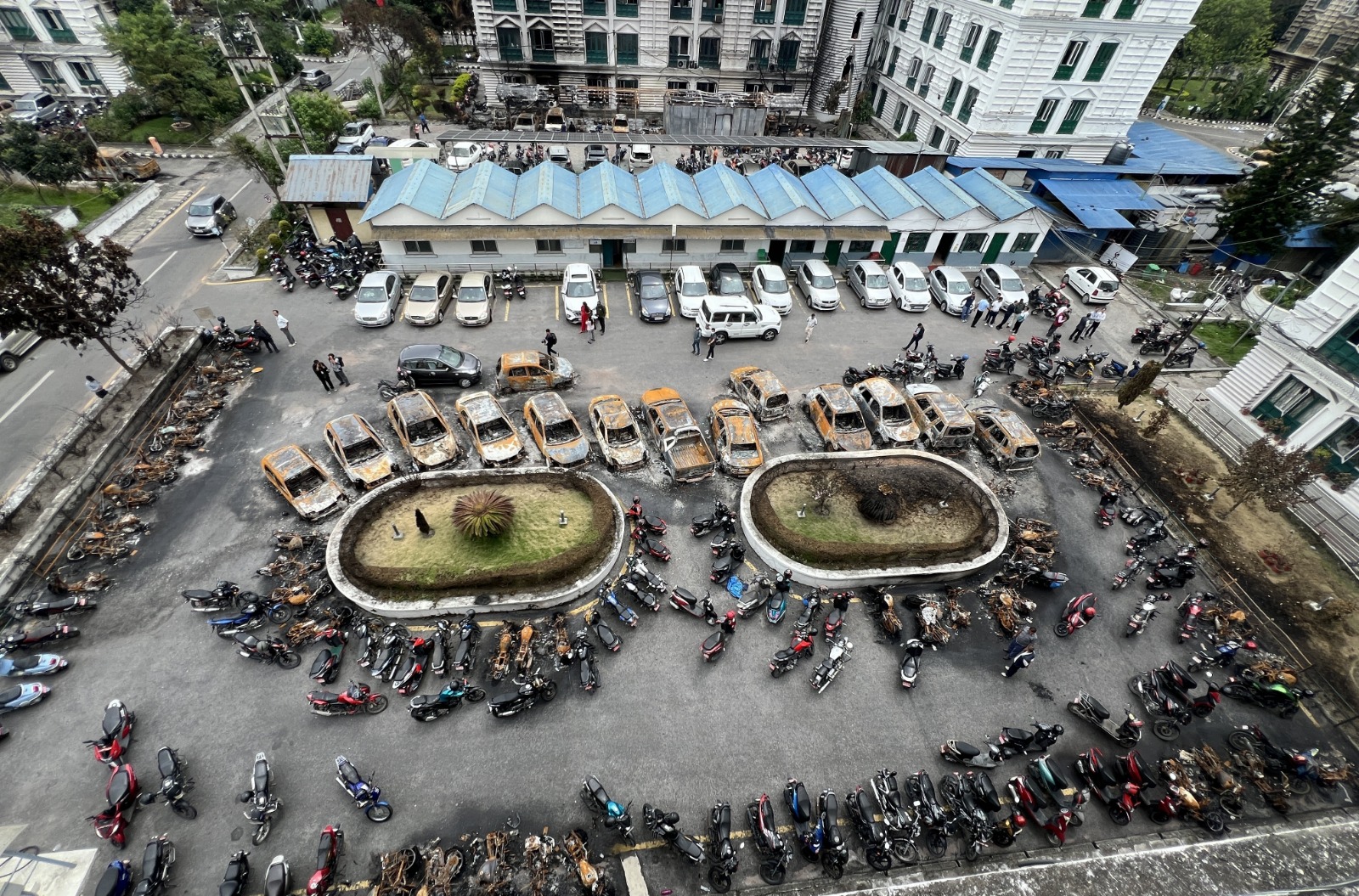
The parking lot of Ministry of Finance inside SIngha Durbar premises on September 13, 2025. Photo: Shikha Shrestha/Nepal News
In terms of budget, the Ministry of Defense spends the most on vehicles after the Home Ministry. According to PAMS, the Ministry of Defense has 1,140 vehicles. However, the size of the budget spent is disproportionate to this number of vehicles. Defense spent the highest budget on fuel and vehicle maintenance. Out of the budget allocated to the Defense Ministry in the last five years, over RS 2.34 billion was spent on fuel and Rs 850.7 million in the name of vehicle maintenance.
A lump sum Rs 275 million was sent to the Ministry of Defense for the purchase of new vehicles, while over Rs 11.4 million was allocated for the driver’s salary. In this way, the Ministry of Defense spent over Rs 3.48 billion on vehicles in five fiscal years.
Almost all governments before the Gen Z movement declared control over wasteful spending and austerity in public expenditure. However, the expenditure incurred by government bodies in the name of vehicles and fuel is alarming.
Another example of exorbitant spending is the Office of the Prime Minister and Council of Ministers. There, too, a flood of budget is seen in the name of operating vehicles. The Prime Minister’s Office had 219 vehicles, including 84 four-wheelers and 135 two-wheelers, and a total of 1,604 vehicles, including 1,385 under its subordinate bodies. According to Prime Minister’s Office Spokesperson Rabi Sharma, 119 vehicles, including 47 four-wheelers and 75 two-wheelers, were burned in the September 9 arson.
In the last five fiscal years, the Prime Minister’s Office spent the most on fuel, at Rs 531.2 million. Similarly, Rs 370 million was allocated for driver’s salary, 310 million rupees for vehicle maintenance, and Rs 59 million for the purchase of new vehicles.
Such excessive expenditure by federal ministries and other government bodies in the name of vehicles has added an unnecessary burden to the state treasury. However, state bodies did not pay attention to minimizing such extravagant spending and maintaining austerity.
Former Finance Secretary Krishnahari Baskota says that the mentality of government officials and employees where their identity and prestige are conferred by the brand of the vehicle is dominant. He argues that this is why expenditure in the name of vehicles has not been cut.
He suggests that instead of buying cars for everyone, the state should only provide facilities to a limited number of officials and cut vehicle facilities for others. “Every secretary is driving a vehicle worth an average of around 10 million rupees. A huge amount is also being spent on fuel, driver’s salary, and vehicle maintenance headings,” Baskota says. “The state must create and implement a single standard to cut this. But since there is not even a simple discussion on these issues, the misuse of government vehicles has not decreased.”
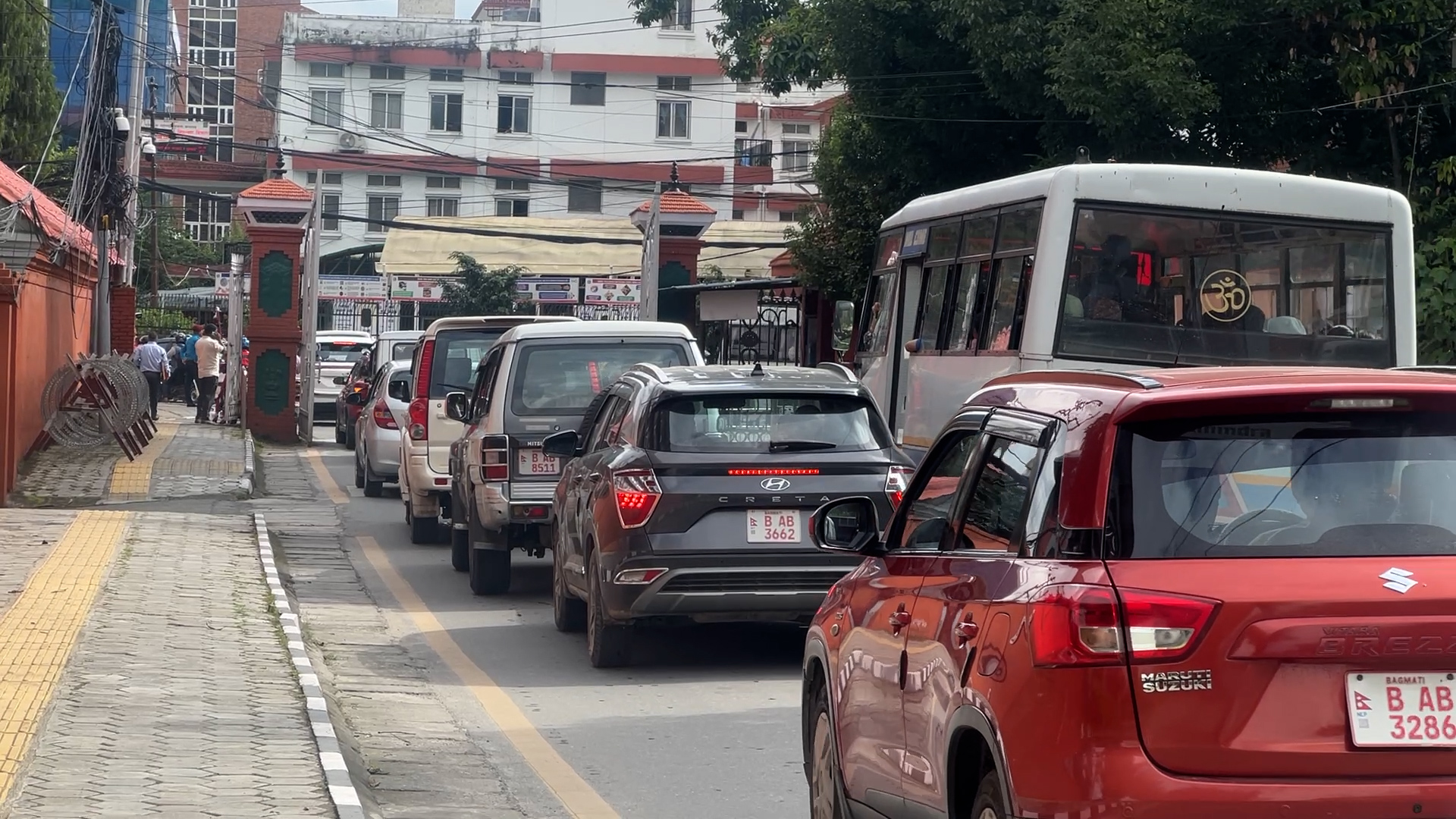
Government vehicles leaving Singha Durbar. Photo by Shikha Shrestha/Nepal News
Standard for vehicle facility
The Cabinet had issued the ‘Vehicle (Operation and Maintenance) Directive, 2015 for the operation and maintenance of government vehicles. The operation and management of government facility vehicles have been carried out based on this directive. However, according to Ministry of Finance Spokesperson Tanka Prasad Pandeya, payments related to vehicle facilities for government employees and officials are currently being made according to the ‘Operational Directive, 2020.
The 2015 Directive sets the rules regarding vehicle facilities, driver, maintenance, and fuel management for gazetted special and first-class officials. According to the directive, only officials at the joint secretary level and above receive the facility of a government vehicle, driver, fuel, and maintenance costs. The directive states that the engine capacity of the vehicle will be determined by the post, and monthly maintenance expenses, fuel, and mobile will be provided.
The same directive stipulates that when providing new vehicles, gazetted special and first-class officials are entitled to a vehicle with an engine capacity of 2,000 CC. The directive also includes a provision that officials must take the same vehicle they have been using when transferred elsewhere.
Similarly, officials who receive the vehicle facility are required to arrange for a driver themselves. It is mentioned that they will be provided with a monthly amount equal to the starting salary scale of a third-level driver.
The anomaly in government vehicle purchasing is that even when old vehicles could suffice, there is a tendency in government bodies to buy new ones and exploit the state treasury. Political appointees in various positions, leaders, and employees tend to seek new and comfortable vehicles as soon as they take office.
The directive sets a standard where gazetted special class officials are provided with an amount equivalent to the prevailing market rate for 125 liters of petrol monthly, and gazetted first-class officials for 100 liters.
There is also a facility to provide a quadrennial amount for mobile or grease, and to request additional fuel if the allocated amount is insufficient for travel to other districts in the course of work. This clause in the directive seems to allow room for the misuse of vehicles and fuel. The provisions made by existing rules and laws regarding such vehicle facilities are not found to be followed in practice.
The anomaly in government vehicle purchasing is that even when old vehicles could suffice, there is a tendency in government bodies to buy new ones and exploit the state treasury.
The directive stipulates that Rs 5,000 monthly shall be provided for vehicle maintenance for three years after receiving a new vehicle. This means that even if a new vehicle does not have problems for three years, this facility is still provided, and consequently, 60,000 rupees automatically goes to one person annually.
The directive sets a standard of Rs 10,000 monthly for special class officials and Rs 7,000 monthly for first-class officials using vehicles older than three years.
Former Finance Secretary Baskota says that austerity is not practiced in vehicle maintenance. He says, “There is a lack of transparency in the fuel facility. Maintenance expenses are also allocated in the name of new vehicles, and the budget allocated for maintenance is spent even if the vehicle does not break down.”
He is of the opinion that government employees and officials should not take maintenance expenses in the name of new vehicles on a basis of ethics.
The exploitation of the state in the name of government vehicles is not limited to the federal level. Vehicle facilities are also provided to officials in federal government offices, provinces, and local bodies, including those with political appointments.
There are government vehicles in approximately 10,000 government bodies across the country. According to PAMS, there are 29,181 government vehicles in 49 federal bodies and their subordinate offices.
Due to the lack of proper management of vehicles in government bodies, financial irregularities are also being encouraged. Most government vehicles are misused rather than utilized properly. This has not only increased the unnecessary financial burden on the state but has also raised questions about the ethics of public officials. This disease has spread from the federal level to the provincial and local levels.
Former Secretary Baskota says that the tendency of employees and officials to consider their uniform and expensive vehicles as the identifier of their position is prevalent, and they use this to show off their prestige.
“Identity is determined by a person’s capability and behavior that is respected by the general public. One is known by their work and service among the people, not by riding in expensive cars,” he says.
“In developed countries, very high-ranking officials ride bicycles, but in Nepal, one must show off their prestige.” He argues that the state system itself has determined the identification of the post by giving special facilities, and this must be changed.
At the federal level, the Home Ministry provides vehicle facilities to special class and first-class officials. Vehicle facilities are given to gazetted special class officials of the Government of Nepal, including the Chief Secretary, Secretaries, and Joint Secretaries.
Due to the lack of proper management of vehicles in government bodies, financial irregularities are also being encouraged. Most government vehicles are misused rather than utilized properly.
Similarly, office chiefs also receive vehicle facilities. If a Nayab Subba (Non-Gazetted First Class) is an office chief in any office, a vehicle facility is provided based on the role.
‘Pool vehicles’ are kept in some important offices. For example, in the Ministry of Finance and other bodies, pool vehicles transport employees to and from the office and take them somewhere for office work purposes. However, such vehicles are often misused for personal rather than office use.
Suggestions from study reports
The Government of Nepal formed Public Expenditure Review Commission with five experts in 2018 to review public expenditure and conduct a study. The commission pointed out that government vehicles, maintenance, and fuel played a major role in the increase in government expenditure.
According to the commission’s report, vehicle maintenance is a major reason for the increase in current expenditure. The report stated that as the number of vehicles, including jeeps, vans, and buses, increases by hundreds every year, the maintenance cost also increases.
The report included the necessity of setting standards for vehicle purchasing and adopting a policy of not purchasing new vehicles for three years in all offices except new ones.
The commission’s report suggested that once a vehicle is provided to an official who receives the facility, they should use the same vehicle for 12 years, and they should take the same vehicle when transferred to any office. The commission suggested to the government that the type and standard of the vehicle should be as specified by the Government of Nepal.
On November 22, 2024, the Cabinet meeting formed a task force led by Arun Kumar Katuwal, Chief of the Mechanical Training Center. The task force, formed to collect the inventory of unused government vehicles and suggest management measures, submitted its report to the Ministry of Physical Infrastructure and Transport on April 27, 2025. However, the task force could not obtain the actual data to analyze government vehicles and equipment. Nine federal bodies, including seven federal ministries, concealed the details of their vehicles from the task force.
Among those who did not submit details until the task force prepared the preliminary report were the Office of the Prime Minister and Council of Ministers and the Ministry of Finance.
According to the commission’s report, vehicle maintenance is a major reason for the increase in current expenditure. The report stated that as the number of vehicles, including jeeps, vans, and buses, increases by hundreds every year, the maintenance cost also increases.
According to the law, everybody must inspect their inventory within two months of the end of each fiscal year. As per this, vehicles that should have been auctioned could not be auctioned according to the process.
The task force concluded that vehicles were in a state of disrepair because one government body would request vehicles from another body and transfer them without fulfilling the specified procedure, and also because vehicle records were not properly maintained.
Similarly, the task force concluded that the vehicles determined to be auctioned could not be sold at a higher price because vehicle tax and renewal fees were not paid, and paying the outstanding tax led to unauthorized expenditure. The task force did not even find the ‘blue books’ for some vehicles. The task force report also mentions that vehicles were not regularly maintained as they should have been.
The task force suggested establishing a separate body with skilled manpower for a permanent solution, including the repair, auction, and conversion of government vehicles, and managing unused and derelict vehicles.
The committee, which could not even obtain sufficient data, said that it should be mandatory to enter the details of all vehicles in PAMS. The task force suggested to the government that the Transport Management Act and the Provincial Vehicle Act should be amended to allow new vehicles to be taken using the ‘buy-back method,’ where old vehicles are returned to the concerned company’s name and then registered for private use.
It estimated that transferring old government vehicles to technical schools for practical learning would be appropriate. The task force also suggested to the government that coordination with the provincial government should be made to cancel the registration of vehicles with outstanding tax and that canceling the registration during the auction would exempt the tax.
The task force’s report shows that according to the details received from 40 out of 49 federal bodies, 2,160 vehicles in 560 offices are in an unused condition, and 1,584 vehicles are in a condition where they should be immediately auctioned.
The report showed that government vehicles worth over 511.7 million rupees eligible for auction are sitting idle. Additionally, the task force report states that the value of 713 old vehicles could not be ascertained.
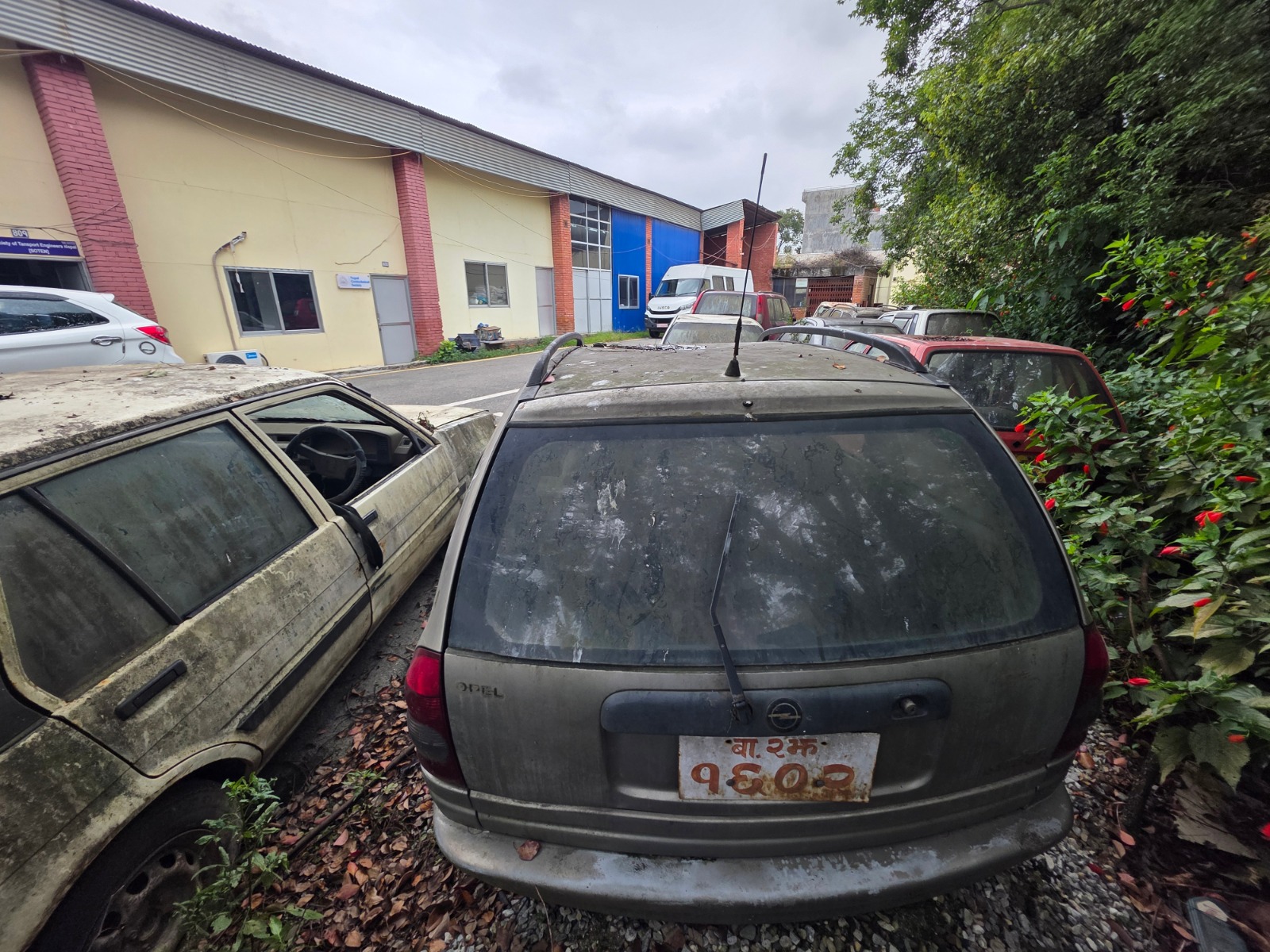
Stored at the Department of Roads Mechanical Training Center in Patandhoka, Lalitpur, these old government vehicles avoided destruction during the recent Gen Z protest. Photo: Shikha Shrestha/Nepal News
Shelved study reports
The reports of task forces, committees, and commissions formed by the government from time to time to control the exploitation in the name of government vehicles have been shelved. The High-Level Federal Administrative Restructuring Committee, formed in 2017 under the chairmanship of former secretary Kashi Raj Dahal, and the High-Level Administrative Reform Implementation and Monitoring Committee, formed in 2019, submitted their reports. However, Dahal says that the government did not implement the suggestions given in these reports.
The report of the committee led by Dahal suggested making administrative offices smaller, rearranging the staff positions, and discouraging the purchase of expensive vehicles.
Dahal says, “Some government officials do not return vehicles even after stepping down from office. There is a situation where the government has to demand the return of vehicles by decision. Even when government vehicles are intended to be misused, there is a tendency to take more facilities than prescribed by the laws.”
On September 21, the interim government decided to eliminate the facilities of former high-ranking officials, including the personal secretary provided to parliamentarians, with the objective of cutting unproductive expenditure, after which some returned government vehicles.
Former Speakers Krishna Bahadur Mahara and Onsari Gharti, and former National Assembly Chairman Ganesh Prasad Timilsina, who were taking vehicle facilities despite no legal provision, returned the vehicles.
Similarly, Bishnu Sapkota, personal secretary to National Assembly Chairman Narayan Prasad Dahal, and Tej Prakash Bhattarai, personal secretary to Speaker Devraj Ghimire, also returned the vehicles. This instance shows the extent of the misuse of government vehicles and the exploitation of the state treasury.
Dahal claims that keeping the government vehicle logbook regular and systematic would also eliminate many irregularities. “There is a provision to keep a logbook, but there is no tendency to write updated details about which vehicle was used at what time, for what work, and how. Those who misuse it are also not punished,” he says. He also suggests that the government should formulate a policy to discourage the tendency to purchase expensive vehicles.
There is a tendency to place expensive vehicles in various projects and for those in government to call for them and use them privately. There are people who use government vehicles for family work and excursions, transporting goods, and even learning to drive.
Budget increased further
The government has further increased the budget allocation for the four vehicle headings for the current fiscal year 2025/2026. According to information provided by the Ministry of Finance, 9.32 billion rupees has been allocated for the operation and management of vehicles for federal ministries alone in the current fiscal year.
Out of that, 1.50 billion rupees has been allocated solely under the driver’s salary heading. Similarly, 3.90 billion rupees has been allocated for vehicle fuel. 1.79 billion rupees has been allocated for vehicle maintenance. The government had allocated 2.11 billion rupees for vehicle purchase.
After the Gen Z movement, vehicles of most ministries were burned. The government formed after the movement has adopted a policy of not purchasing new vehicles.
The government has adopted a policy of not buying new vehicles in the current fiscal year, citing the need to cut unnecessary expenditure. Joint Secretary of the Ministry of Finance, Tanka Prasad Pandeya, says, “The government has adopted a policy of not buying new vehicles. The Ministry of Finance has decided not to purchase any new vehicles. Even if other ministries request consent to buy vehicles, a decision will only be made after considering the nature of the necessity.”
According to Pandeya, the management is currently being done by transferring vehicles from offices where they are less necessary to offices where they are more necessary.